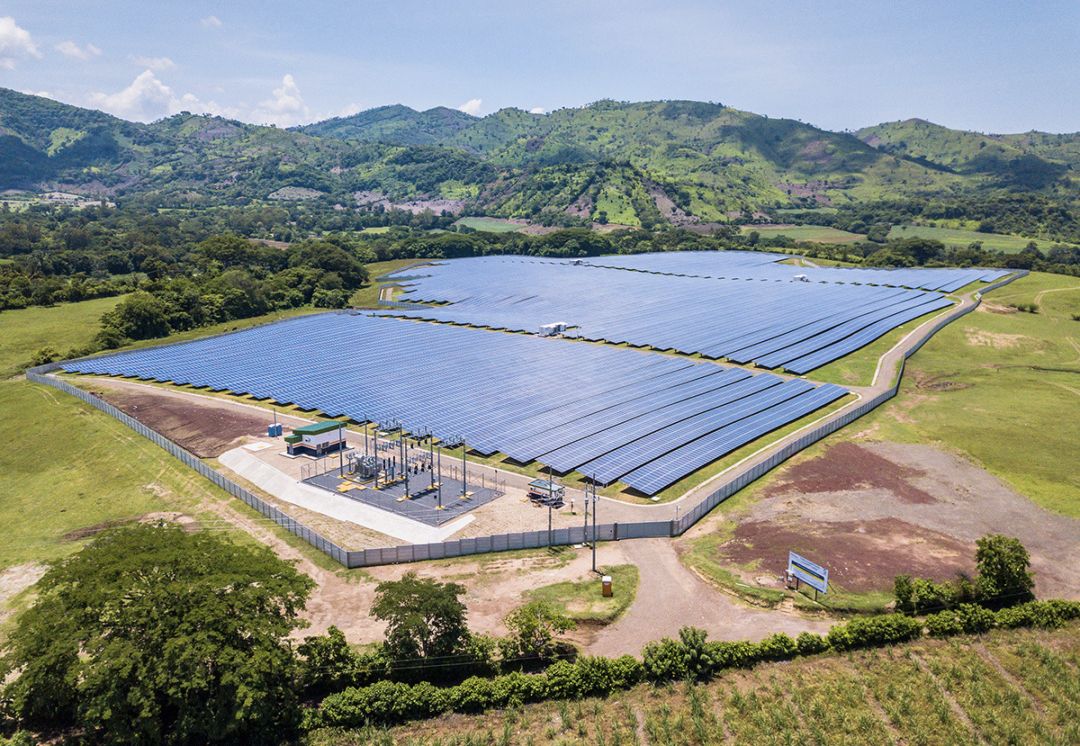Disclaimer:
Please be aware that the content herein has not been peer reviewed. It consists of personal reflections, insights, and learnings of the contributor(s). It may not be exhaustive, nor does it aim to be authoritative knowledge.
Title
Please provide a name for your action learning plan.
Digital AgroEnergy: Sustainable Innovation in Agri-Food Development
Challenge statement
Challenge type: If you are working on multiple challenges, please indicate if this is your "big bet" or "exploratory" challenge.
Please note: we ask you to only submit a maximum of 3 challenges - 1x Big Bet, 2x Exploratory. Each challenge must be submitted individually.
BIG BET
Challenge statement: What is your challenge? (Please answer in specific terms: "Our challenge is that...”.)
El Salvador has made significant progress in its energy matrix, with 61% of its installed capacity coming from renewable sources. Plans are currently being developed to further expand geothermal and solar capacity, as well as evaluate the inclusion of other energy sources. However, the country faces challenges in managing high energy costs due to its hybrid model, which involves the participation of both the public and private sectors in the entire energy system.
One of the critical problems is the high cost of private sector participation in energy distribution. Although energy coverage in rural areas has reached 96.6% (EHPM, 2023), closing the remaining gap is costly. Furthermore, energy demand in rural areas is expected to increase, driven by agricultural productivity and socioeconomic activities such as tourism.
Next year, the country will propose a comprehensive review of the legal and policy framework of the energy sector, which represents an opportunity to include social needs and less developed sectors without slowing economic and sustainable growth.
The agricultural sector, a key contributor to GDP at 4.6% in 2023 and an essential pillar of food security and poverty reduction, faces unique challenges. It relies heavily on non-renewable energy sources, operates with insufficient infrastructure and has low adoption of advanced technologies. These factors increase production costs, limit operational efficiency and endanger food security and the economic sustainability of the sector.
The country's vulnerability to climate change exacerbates these problems, highlighting the urgent need for sustainable energy solutions to strengthen resilience in agri-food production. Addressing these challenges requires a gender-sensitive approach and disaggregated data to develop more effective and inclusive measures.
One of the biggest gaps in the agri-food sector is the lack of accurate and up-to-date data on energy consumption, which makes it difficult to make informed decisions and implement effective energy efficiency policies. In addition, technological, economic and regulatory barriers hinder the integration of renewable energies and digital technologies—such as the Internet of Things (IoT), and Artificial Intelligence (AI)—that have the potential to transform the sector into a more sustainable and competitive model.
Background: What is the history of your challenge? What is causing or driving it? Who is involved? How does the current situation look like? What undesired effects does it produce?
El Salvador has made considerable advances in transforming its energy matrix, with a notable 61% of its installed capacity now coming from renewable sources. This shift is part of a broader global trend towards renewable energy, driven by the desire to reduce reliance on fossil fuels, combat climate change, and promote energy independence. However, the country still faces challenges due to its hybrid energy model, which includes both public and private sector involvement. The inclusion of private sector players in the energy distribution system is contributing to high costs, which places a financial burden on consumers and the economy.
The situation is further complicated by the growing energy demand in rural areas, which is expected to rise as agricultural productivity and tourism expand. While there has been impressive progress in providing energy coverage—reaching 96.6% of rural areas in 2023—closing the remaining gap is expensive and resource-intensive.
Quantitative evidence: What (official) data sources do you have on this challenge that better exemplifies the importance and urgency of this frontier challenge? You can add text, a link, or a picture.
Data bases from the General Directorate of Energy, Hydrocarbons and Mines on kW consumed in the country and survey data bases collected by FAO.
Qualitative evidence: What weak signals have you recently spotted that characterizes its urgency? Please provide qualitative information that better exemplifies the importance and urgency of this frontier challenge. You can add text, a link, or a picture.
https://ground.news/article/hydropower-and-lng-propel-el-salvadors-energy-growth-in-2024?utm_source=chatgpt.com
Value proposition: What added value or unique value proposition is your Accelerator Lab bringing to solving this challenge? Why is it your Lab that needs to work on this challenge and not other actors within UNDP, other stakeholders in the country respectively? Why is it worth investing resources to this challenge?
Our Accelerator Lab brings unique value through its experience in prototyping, conducting experiments to test innovative solutions, and leveraging Machine Learning to predict labeled outcomes. Our approach enables rapid learning cycles, uncovering insights traditional methods might miss. By integrating data-driven experimentation with systems thinking, we generate evidence-backed solutions tailored to local contexts. No other UNDP actor combines agile methodologies with AI-driven insights in this space, making our Lab the ideal platform to tackle this challenge efficiently and effectively.
Short “tweet” summary: We would like to tweet what you are working on, can you summarize your challenge in a maximum of 280 characters?
Our Accelerator Lab is experimenting & using machine learning to predict consumption in electric energy, through IoT to uncover insights & supercharge data-driven solutions! We push boundaries, test bold ideas & accelerate impact where it matters most! 🔥⚡ #Innovation #AI #Energy
Partners
Who are your top 5 partners for this challenge? Please submit from MOST to LEAST important and state Name, Sector and a brief description of the (intended) collaboration.
Please state the name of the partner:
FAO
General Directorate of Energy, Hydrocarbons and Mines
ENA
CENTA
What sector does our partner belong to?
Government (&related)
Please provide a brief description of the collaboration.
Our Accelerator Lab collaborates with stakeholders to prototype, experiment, and apply data-driven solutions to complex challenges. We bring together innovators, policymakers, and communities to test bold ideas, leverage Machine Learning, and generate evidence-based insights—accelerating impact in key sectors like electric energy. By fostering an agile, learning-by-doing approach, we ensure solutions are locally relevant, scalable, and transformative.
Is this a new and unusual partner for UNDP?
No
Learning questions
Learning question: What is your learning question for this challenge? What do you need to know or understand to work on your challenge statement?
How can disaggregated energy consumption data combined with advanced technologies —such as IoT— and real-time monitoring—improve energy efficiency and reduce operational costs in the agrifood sector? What are the key barriers and enablers for adoption and scalability?
To what stage(s) in the learning cycle does your learning question relate?
Sense, Explore, Test
Usage of methods: Relating to your choice above, how will you use your methods & tools for this learning question? What value do these add in answering your learning question?
1. Artificial Intelligence/Machine Learning – To analyze disaggregated energy consumption data, identify patterns, and optimize energy efficiency.
2. Ethnography – To understand the behaviors, challenges, and needs of agro-food sector stakeholders in their energy use.
3. Human-Centered Design (HCD) – To co-create solutions with end-users, ensuring technological interventions align with real-world needs.
4. Pilots & Experimentation – To test AI-driven solutions in real-world settings, iterating based on data and user feedback.
5. Systems Thinking – To map interdependencies and identify leverage points for scaling energy efficiency innovations across the agro-food sector.
Existing data gaps: Relating to your choice above, what existing gaps in data or information do these new sources of data addressing? What value do these add in answering your learning question?
One of the main challenges in optimizing energy efficiency in the agro-food sector is the lack of detailed, disaggregated energy consumption data. Current data is often aggregated at a general level (e.g., total farm or facility consumption), making it difficult to pinpoint where, when, and how energy is being used inefficiently.
Closing
Early leads to grow: Think about the possible grow phase for this challenge - who might benefit from your work on this challenge or who might be the champions in your country that you should inform or collaborate with early on to help you grow this challenge?
This can be escalated to other sectors like industry, households, retails, etc
END OF ACTION LEARNING PLAN: Thank you! The form saves automatically and your submission has been recorded. You may now exit this window.


 2Zero hunger
2Zero hunger

 9Industry, innovation and infrastructure
9Industry, innovation and infrastructure 13Climate action
13Climate action
Comments
Log in to add a comment or reply.